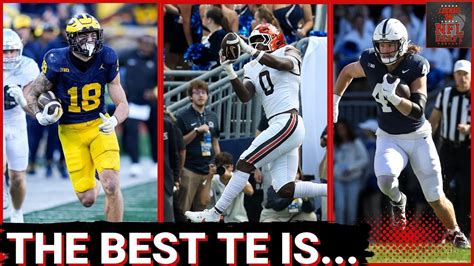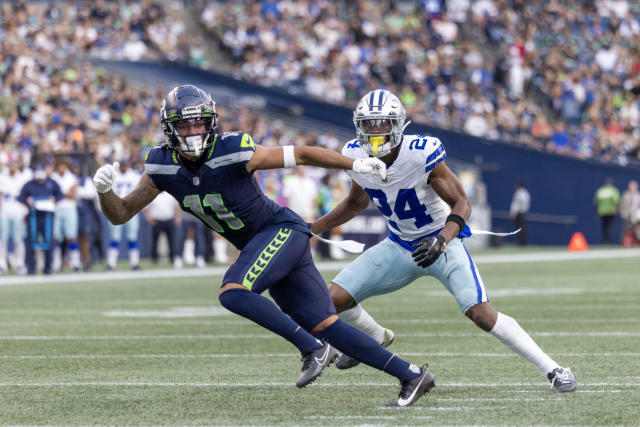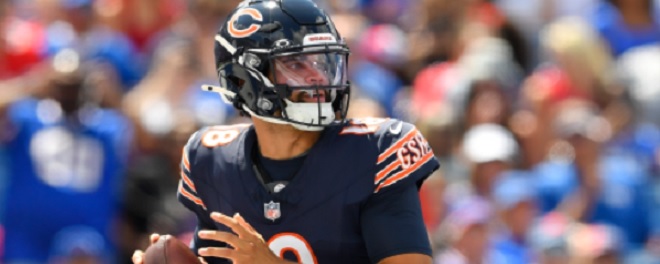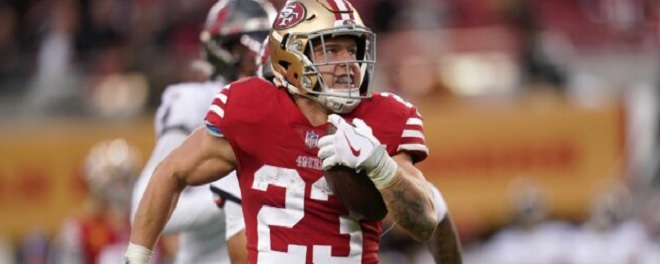Position Review: Tight Ends
Tight End ClassEarly-round talent: A
Mid-round: B+
Late-round: B+
Overall grade: A-
2025 prospects vs 2024
Brock BowersTyler Warren
Elijah Arroyo
Colston Loveland
Mason Taylor
Ben Sinnott
Harold Fannin Jr.
Tip Reiman
Ja’Tavion Sanders
Theo Johnson
Just to be clear, this article and series are all my opinion. I base my evaluation on my own film study and also on information I’ve gotten from general managers, directors of college scouting, national scouts, area scouts, and NFL coaches who know way more than I do.
The 2024 NFL Draft was a bad year for tight ends. Brock Bowers was a star, but after him, the class was very weak. There were only two tight ends taken in the top 80 picks, and only three tight ends went on the first two days of the draft. This year’s group is massively more talented.
If you were to merge the two classes it would be an easy comparison as the 2023 group dominates. However, Brock Bowers would be the top overall prospect as he could go top-16 in any draft class. Warren, Arroyo, Loveland, and Taylor are all better prospects than Sinnott was last year. Harold Fannin Jr. is a better prospect than third-rounder Tip Reiman.
Safest Pick: Colston Loveland, Michigan 
Previous Picks:2023 Brock Bowers
2023 Sam LaPorta
2022 Trey McBride
2021 Kyle Pitts
2020 Adam Trautman
2019 T.J. Hockenson
2018 Hayden Hurst
2017 O.J. Howard
2016 Hunter Henry
2015 Clive Walford
2014 Eric Ebron
2013 Zach Ertz
Loveland is a safe bet to be a very good starting tight end as long as he can stay healthy. Loveland is a dangerous receiver that is a playmaker in the passing game. While he is not a dominator as an in line blocker, the potential is there for him to be well-rounded. Loveland could turn into a good starter early in his pro career.
Biggest Bust Potential: Harold Fannin Jr., Boise State 
Previous Picks:2024 Brevyn Spann-Ford
2023 Will Mallory
2022 Grant Calcaterra
2021 Hunter Long
2020 Hunter Bryant
2019 Noah Fant
2018 Jordan Akins
2017 Adam Shaheen
2016 Nick Vannett
2015 Nick O’Leary
2014 Jace Amaro
2013 Gavin Escobar
This was a tough call as none really stood out to me. I think Fannin Jr. could have issues as a blocker and tight ends who struggle to block are going to top out as rotational players without the ability to be three-down starters.
Tight End Rankings by Attributes
Pass Receiving:
NFL prototype: Brock Bowers, Raiders
- Tyler Warren
- Elijah Arroyo
- Colston Loveland
- Harold Fannin Jr.
- Mason Taylor
Recap: The NFL has evolved to the point where tight ends are a critical part to a potent passing attack. Some teams have better receiving weapons at tight end than they do at receiver. The league is driven by passing, so if a tight end can’t contribute as a receiver, he could have a hard time seeing the field. This draft class has some excellent receiving tight ends for the NFL.
For the NFL, Warren is a dangerous receiver and mismatch weapon. There is no doubt that Warren is a dynamic athlete with speed and agility. He has the skill set to be a dangerous receiver down the seam and in the red zone like he was in college. Warren has enough quickness to get downfield and a burst to accelerate into the open field, but he is not a supremely fast tight end that will burn defenses deep downfield. Warren has excellent hands and is very skilled at going up high to make receptions over defensive backs. His athletic ability can be seen as he has excellent body control and uses his size well to shield the ball from defenders to make receptions. Warren has leaping ability to go along with his size, and he is very dangerous on 50-50 passes.
Arroyo has the skill set to be a dangerous receiver down the seam and in the red zone like he was in college. Arroyo has the quickness to get downfield, and he has a surprising burst for a tight end. He has excellent hands and is very skilled at going up high to make receptions over defensive backs. Even though he isn’t the biggest of tight ends, he has good body control and uses his size well to shield the ball from defenders to make receptions. Arroyo is a twitchy athlete with burst out of his breaks and sudden movement skills. That translates to him being an excellent route runner who can consistently generate separation from linebackers or safeties. Arroyo has good feel as a receiver and can find soft spots in the zone. After the catch, Arroyo is a tough runner who has a burst, will weave through the secondary, and shows the ability to pick up yards downfield. As a pro, Arroyo should be a mismatch problem and dangerous weapon in the passing game.
As a receiver, Loveland can do a lot to help his offense. He is a quick route runner with fluid athleticism to get open in the middle of the field. Loveland has the speed to get down the seam and accelerate to find soft spots in zone coverage. With excellent body control and agility, Loveland makes difficult catches using his body to box out defensive backs and make leaping grabs over them.
Fannin has the potential to be a mismatch receiving tight end with quickness, athleticism, and feel. Fannin is smooth as a route-runner, and linebackers can struggle to run with him. He tracks the ball well downfield and shows late hands to make the catch even when defenders are close. With his quickness and athleticism, Fannin is dangerous with the ball in his hands to rip off more yardage after the catch.
Taylor has the speed and size to be a problem at tight end. With nice technique, Taylor is a superb route runner who does not take extra steps. He presents a big target and can high-point the ball. While Taylor does not have elite speed and athleticism, he definitely has the ability to contribute as a receiver in the NFL.
Blocking:
NFL prototype: George Kittle, 49ers
- Mason Taylor
- Tyler Warren
- Colston Loveland
- Elijah Arroyo
- Harold Fannin Jr.
Recap: Blocking ability is still important for NFL tight ends, Not just in the ground game, but in pass protection. Teams like their tight ends to have the ability to help tackles when they’re going against an elite edge-rusher and contribute to helping cover up tacklers in the rushing attack. To be a good well-rounded starting tight end in the NFL, you have to be able to pass protect and block the c-gap in the ground game. In this group, there isn’t one player that is an elite blocker; all of them have room for improvement.
Taylor is the best of the group. Not only does he have some size and strength, but he shows more attitude and effort than the other four. Team sources have said that Warren, Arroyo, and Loveland are disappointing and underwhelming as blockers. Fannin could have problems blocking at the NFL level.
Red Zone:
NFL prototype: Sam LaPorta, Lions
- Tyler Warren
- Mason Taylor
- Colston Loveland
- Elijah Arroyo
- Harold Fannin Jr.
Recap: Tight ends are critical players in the red zone. Multiple tight ends are needed for goal-line packages. Many teams also like to use double tight end sets inside the 20-yard line. A tight end who is a big target with sure hands and leaping ability is a good weapon to help produce touchdowns instead of field goals. Also being an effective blocker is very helpful in the condensed field, short yardage situations, and goal line. Tight ends that are terrible blockers aren’t options for goal-line packages.
Warren is the best red zone weapon in this group because of his receiving ability, his route running to get open, his size to make contested catches, run after the catch ability, and because he is capable of splitting out and beating man coverage.
Taylor is a close second because not only was he a good red zone contributor as a receiver, but he also blocks well enough to keep defenses guessing on what he might do on any given play. Loveland and Arroyo are potential red zone weapons with their ability to beat coverage. They both have quickness and athleticism to get open with the size to win contested catches. Fannin made some plays in the red zone last year, showing versatility, but he has limitations as a blocker that could get him pulled out of the game at the goal line.
Hands:
NFL prototype: George Kittle, 49ers
- Tyler Warren
- Mason Taylor
- Elijah Arroyo
- Colston Loveland
- Harold Fannin Jr.
Recap: Tight ends with bad hands don’t get thrown the ball often in the NFL. They have a hard time seeing the field and end up only playing in goal-line situations and on special teams. In the group above, there wasn’t one player that stood out as having bad hands.
Warren and Taylor have the best hands of this group and are natural hands catchers. Arroyo has really soft hands and is a natural receiver. Loveland and Fannin have reliable hands overall, but they can have an occasional drop.
Yards After Catch:
NFL prototype: Brock Bowers, Raiders
- Tyler Warren
- Colston Loveland
- Elijah Arroyo
- Harold Fannin Jr.
- Mason Taylor
Recap: There are some tight ends in the NFL who are very dangerous with the ball in their hands. Having the ability to pick up yards after the catch (YAC) is not an easy trait to find in tight ends. This class has some quality yards after the catch tight ends, and none of the five is bad at it.
With his speed, athleticism, and strength, Warren is dangerous after the catch to rip off yards and turn routine catches into big plays. Loveland had some excellent runs after the catch in his career, and he could translate that to the NFL. Arroyo flashes some run-after-the-catch ability, and he made some big plays for Miami over the past season. Fannin and Taylor have the ability to run after the catch as well.





